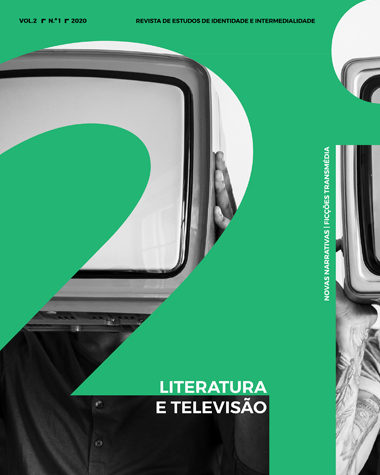O trauma em "Watchmen"
Do "graphic novel" à série de televisão
DOI:
https://doi.org/10.21814/2i.2508Palavras-chave:
Watchmen; trauma; máscaras; graphic novel; série de televisão.Resumo
Em 1987, Watchmen revolucionou o mundo da banda desenhada devido à complexidade dos seus super-heróis e a maneira humana como estes eram retratados. O trauma é um elemento essencial na história, uma vez que tal como afecta a população em geral, afecta também os heróis da narrativa. A série de televisão Watchmen (2019) inspira-se no ambiente e no género de herói que é retratado em 1987, tentando seguir o legado que o graphic novel deixou. Assim, esta breve reflexão foca-se na representação do trauma colectivo e individual no livro e na continuidade que lhes é dada na série de televisão, em que surgem ainda novos traumas, também eles relacionados com a narrativa inicial.
Downloads
Referências
Abad-Santos, A. (2019, novembro 4) Watchmen’s Laurie Blake — and how the show is rewriting her comic book origins. Vox. Consultado em https://www.vox.com/culture/2019/11/4/20941740/watchmen-laurie-blake-jean-smart-episode-three
Blake, B. B. (2009). Watchmen: The graphic novel as trauma fiction. Imagetext, 5 (1). Consultado em http://imagetext.english.ufl.edu/archives/v5_1/blake/
Carey, B. (2018, dezembro 10). Can we really inherit trauma? The New York times. Consultado em https://www.nytimes.com/2018/12/10/health/mind-epigenetics-genes.html
Dietrich, B. (2009). The human stain: Chaos and the rage for order in Watchmen. Extrapolation, 50 (1), pp.120-144.
Dekel, R. e Goldblatt, H. (2008) Is there intergenerational transmission of trauma?: The case of combat veterans’ children. American journal of orthopsychiatry, 78 (3), 281–289.
Ellsworth, S. (s/d). Tulsa race massacre. The encyclopedia of Oklahoma history and culture. Consultado em https://www.okhistory.org/publications/enc/entry.php?entry=TU013
ETH Zurich. (2014, abril 13). Hereditary trauma: Inheritance of traumas and how they may be mediated. Sciencedaily. Consultado em www.sciencedaily.com/releases/2014/04/140413135953.htm
Evans, E. (2020, janeiro 3). Watchmen is a powerful exploration of black trauma, and everyone needs to watch. Huffpost. Consultado em https://www.huffpost.com/entry/watchmen-episode-6-hooded-justice-race-trauma_n_5ddc92ece4b0d50f32958d9e
Fishbaugh, B. (1998) Moore and Gibbons's Watchmen: Exact personifications of science. Extrapolation: A journal of science fiction and fantasy. 39 (3), 189–198.
Galea, S., Ahern, J., Resnick, H., Kilpatrick, D., Bucuvalas, M. e Gold, J. (2002). Psychological sequelae of the September 11 terrorist attacks in New York city. The New England journal of medicine. Consultado em https://www.nejm.org/doi/full/10.1056/NEJMsa013404
Hatfield, C., Heer, J. e Worcester, K. (2013). The superhero reader. Mississipi: University Press of Mississippi.
Hirschberger, G. (2018). Collective trauma and the social construction of meaning. Frontiers in Psychology. Consultado em https://www.frontiersin.org/articles/10.3389/fpsyg.2018.01441/full
Hughes, J. (2006). “Who watches the Watchmen?”: Ideology and ‘real world’ superheroes. The journal of popular culture, 39 (4), 546–557.
Jones, M. (2019). How Watchmen explores generational black trauma and provides a path beyond the pain. Shadow and Act. Consultado em https://shadowandact.com/how-watchmen-explores-generational-black-trauma-and-provides-a-path-beyond-the-pain
Keating, E. M. (2011). The female link: Citation and continuity in Watchmen. The journal of popular culture, 45 (6), pp.1266-1288.
Lindelof, D. (Produtor). (2019). Watchmen [Série televisiva]. Estados Unidos da América: HBO.
Mahmutović, A. (2018). Chronotope in Moore and Gibbons’s Watchmen. Studies in the novel. 50 (2), 255–276.
Moore, A. (Escritor) & Gibbons, D. (Ilustrador). (1987). Watchmen. : DC Comics.
Norman, S. (2019). Treating guilt and shame resulting from trauma and moral injury. The international society for traumatic stress studies. Consultado em https://istss.org/public-resources/trauma-blog/2019-september/treating-guilt-and-shame-resulting-from-trauma-and
Pellitteri, M. (2011). Alan Moore, Watchmen and some notes on the ideology of superhero comics. Studies in comics, 2 (1), 81–91.
Sundar, P. (2019). Watchmen episode 5: Wade Tillman's journey to become Looking Glass is filled with deep despair and trauma of surviving the giant squid. Meaww. Consultado em https://meaww.com/watchmen-episode-5-review-wade-tillman-looking-glass-rorschach-seventh-kavalry-attack
Thomson, I. (2005). Deconstructing the hero. In Comics as philosophy (pp. 100–129). Jackson: Universtiy of Mississippi.
Willenborg, P. (2019). “Wounds need air”: Personal trauma in Watchmen. 25YL. Consultado em https://25yearslatersite.com/2020/01/09/wounds-need-air-personal-trauma-in-watchmen/
Wright, B. (2001). Comic book nation: the transformation of youth culture in America. Baltimore: The John Hopkins University Press.
Wolk, D. (2007). Reading comics: How graphic novels work and what they mean. Cambridge, MA: Da Capo Press.


.jpg)










